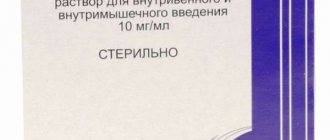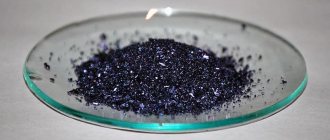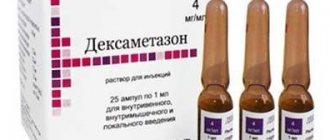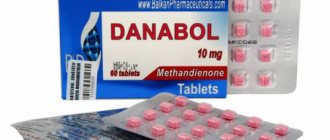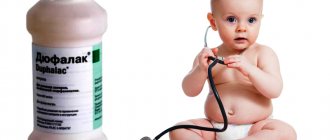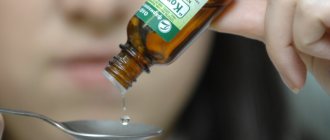An overdose of Finlepsin often occurs as a result of prolonged adsorption of the drug in the gastrointestinal tract . The desire to alleviate one’s condition as quickly as possible forces a person to exceed the number of tablets recommended by the doctor. As a result, within a day the body develops severe intoxication, which occurs against the background of respiratory failure. The danger of finlepsin poisoning lies in the lack of a complex antidote and little knowledge of the active substance.
About the drug
Finlepsin (active ingredient - carbamazepine) is used for the prevention and treatment of attacks of epilepsy, schizophrenia, drug and alcohol addiction. The drug is available in standard or extended-release tablets. The prolonged form of the drug is often used for convulsive syndrome.
1 tablet of Finlepsin retard contains 200 or 400 mg of carbamazepine. Poisoning with Finlepsin is due to the pharmacokinetic characteristics of the drug.
After taking the drug orally, its effect does not begin immediately. The substance is metabolized by the liver within several hours and delivered to target organs. The drug exhibits medicinal properties one day after use.
Indications for use:
- affective insanity;
- trigeminal neuralgia;
- phantom pain;
- diabetic neuropathy;
- polyuria of neurogenic origin.
For the purpose of prevention, Finlepsin is used in patients prone to recurrent seizures. The drug is also indicated for eliminating limb tremors and neurogenic pain syndrome.
Finlepsin poisoning – consequences for the brain and body. Finlepsin – all about Finlepsin
Taking Finlepsin is contraindicated during pregnancy, hypersensitivity to the components of the drug and the presence of allergic reactions. Possible side effects include:
- headache, drowsiness, dizziness;
- nervous tic, tremor of limbs;
- speech problems;
- trembling of the eyeball;
- increased excitability, mental disorders;
- allergic reactions on the face and throughout the body;
- problems with the gastrointestinal tract;
- presence of blood in the urine;
- chills, fever combined with excessive sweating.
Very often, similar consequences are observed if the medicine is taken with alcohol. In this case, a serious danger arises even when the dose of the drug is not exceeded.
Alcoholic drinks have the opposite effect on the body: they increase blood pressure and heart rate, which leads to a severe hypertensive crisis, including death. Therefore, using Finlepsin together with alcohol is strictly prohibited.
What happens when the drug is combined with alcohol?
Combining medicine with alcohol is unacceptable, but there are still people who are not afraid of the consequences. However, such violators often simply do not think about them.
Firstly, any alcoholic drink is a depressant. The action of Finlepsin is aimed at eliminating such a negative state. It turns out that the entire effect of the treatment is reduced to zero.
Secondly, the body begins to sharply produce a large dose of adrenaline. The heartbeat quickens, blood pressure increases greatly, and spasms begin in small vessels. In most cases, taking finlepsin simultaneously with alcohol becomes the main cause of a hypertensive crisis.
Thirdly, this threatens to disrupt the entire therapy. Since during treatment it is required to give up alcohol, the patient suffers greatly from addiction. Finlepsin is prescribed to relieve their condition after all the toxins from their body have been eliminated. The medicine stops cravings for alcohol.
If alcohol begins to enter the body again, the liver is the first to suffer. She is forced to cope with medications and toxins, the impact of alcohol leads to disruption of her work. In case of liver disease, Finlepsin is immediately discontinued and treatment of the affected organ is prescribed.
Fourthly, drinking alcohol simultaneously with the drug often causes suicide. This “cocktail” causes psychological disturbances and severe loss of strength. The patient begins to be tormented by very dark thoughts.
In addition, a person who violates the doctor’s instructions is at risk of allergic reactions, endocrine system failure, and problems with the heart and nervous system. Finlepsin is characterized by a prolonged action, so you should not drink it even after the end of therapy.
Alcohol addiction is one of the most dangerous diseases that can be equated to drug addiction. Various methods and medications are used to treat it.
They help not only get rid of harmful desires, but also neutralize all the negative effects of alcohol on the body.
But, in addition to disruption of the functioning of internal organs, there is also a detrimental effect on the human psyche, so it is necessary to take a drug such as finlepsin.
It is important for the patient not only to start taking appropriate medications, but also to prevent any, even the slightest, consumption of alcohol. Alcohol causes various disorders and deterioration of general condition. But it is worth remembering that if Finlepsin is taken, then drinking alcohol is strictly prohibited.
The drug should not be taken for a long time; treatment should be carried out under the supervision of a doctor.
Finlepsin indications for use
The antiepileptic drug Finlepsin is prescribed to those patients who suffer from the following diseases and conditions:
- In epilepsy, when the presence of partial seizures with ordinary symptoms, partial seizures with complex symptoms, psychomotor seizures, grand mal seizures mainly during night rest or diffuse grand mal seizures, as well as mixed forms of the disease are diagnosed;
- For trigeminal neuralgia;
- For idiopathic neuralgia of the glossopharyngeal nerve;
- For pain caused by diabetic polyneuropathy;
- For epileptiform convulsions in patients suffering from multiple sclerosis, for spasms of the facial muscles in patients suffering from trigeminal neuralgia, for tonic convulsions, paroxysmal dysarthria and ataxia, paroxysmal paresthesias and painful attacks;
- For symptoms of alcohol withdrawal syndrome in the form of anxiety, seizures, hyperexcitability and sleep disturbances;
- For psychotic disorders in the form of affective and schizoaffective disorders, psychoses;
Contraindications
When prescribing the drug, existing contraindications for its use should be taken into account. Finlepsin should not be prescribed to those patients who have the following conditions:
- For hematopoietic disorders in bone marrow tissue with a diagnosis of anemia and leukopenia;
- For acute intermittent porphyrias;
- With atrioventricular block;
- When prescribing antidepressants and lithium drugs simultaneously;
- In case of hypersensitivity to the components of the drug;
- With increased sensitivity to tricyclic antidepressants;
Finlepsin requires careful use in the following cases:
- decompensated chronic heart failure;
- dysfunction of the liver, kidneys;
- in old age;
- chronic alcoholism;
- dilution hyponatremia (with ADH hypersecretion syndrome, hypopituitarism, hypothyroidism, adrenal insufficiency),
- inhibition of bone marrow hematopoiesis;
- prostatic hyperplasia,
- increased intraocular pressure;
- joint use of sedative and hypnotic drugs.
Source: https://GolovaNeBoli.ru/alkogolizm/peredozirovka-finlepsinom-pobochnye-dejstviya-i-effekty-pri-otravlenii.html
Dosage and administration of finlepsin
In adults, a dose of 1-2 tablets is usually used (depending on body weight, age and pathology). For some diseases, a specific treatment regimen is required, according to which the amount of the drug is gradually increased to 0.6-1.1 g per day (occasionally 1.8 g) . Exceeding the dosage provokes severe adverse reactions. To avoid unwanted effects, you should take the tablets after or during meals.
In case of intense pain, 0.8 g is prescribed until complete relief. In case of withdrawal syndrome, a dose of 0.2 g is indicated for the prevention of psychosis. The doctor can increase it by prescribing Finlepsin Retard 400 mg if only one drug is used. With complex therapy, the dose of the drug should not exceed 200 mg.
Since the drug is taken for a long time, the concentration of carbamazepine in the patient’s blood is taken into account to determine the optimal dosage. The initial dose in children over 6 years of age is 0.2 g, it is gradually increased until the optimal dose is reached. The maintenance daily dosage for a child is 0.4–0.6 g.
During treatment, it is important to maintain a drinking regime; water helps the absorption of the medicine and the removal of its residues. The tablets should be taken with plenty of water. If edema appears, you should consult a doctor for examination for pathologies of the kidneys and endocrine organs.
Summary
By following all the rules for taking such a serious drug, we reduce the possibility of toxic poisoning. Of course, no one excludes either an allergic reaction to individual components or a psychological one. To protect yourself and others as much as possible, try to first undergo a complete examination of the body and blood, as indicated above. Remember that self-medication without prior preparation is unsafe.
Also read - Symptoms of tramadol overdose, is death possible and what to do
Main causes and symptoms of overdose
Overdose mainly occurs when the medication dosage schedule is not followed.
You cannot skip a dose and then compensate for it with a double dose; you must leave everything as is and simply continue treatment according to the prescribed regimen. Exceeding the dose once is not dangerous; intoxication usually develops when a certain amount of the drug accumulates in the blood. The consequences of an overdose of Finlepsin depend on many factors: the state of health, the age of the patient, the dose taken and the total duration of treatment.
Symptoms of mild poisoning:
- dizziness, loss of coordination;
- weakness, polysemy, irritability;
- abdominal pain, nausea, vomiting;
- sweating, shortness of breath;
- hyperpigmentation;
- weight gain, edema.
More serious violations:
- visual and auditory hallucinations;
- attacks of aggression;
- violation of spatial orientation;
- fussiness, anxiety;
- memory and speech impairment;
- psychosis.
Finlepsin often causes allergic reactions in the form of skin flushing and urticaria, sometimes they are quite serious. Allergies can be diagnosed based on the following symptoms: itching, coughing, sneezing, watery eyes. If your temperature rises, your skin peels, or you feel weakness in your limbs, you should seek medical help. Perhaps these are symptoms of erythroderma.
The drug is mainly used in a hospital under medical supervision, since an overdose is very dangerous. The lethal dose of the drug depends on many factors and varies widely. The medicine is very strong and the consequences of poisoning are unpredictable.
Composition and release form
Finlepsin is available in the form of round, white, chamfered tablets that are convex on one side and have a wedge-shaped groove on the other. Composition of Finlepsin:
| Compound | Weight, mg |
| Carbamazepine (active ingredient) | 200 |
| Auxiliary components: | |
| Microcrystalline cellulose | 60 |
| Gelatin | 11 |
| Croscarmellose sodium | 6 |
| Magnesium stearate | 3 |
Treatment and first aid for poisoning
Is death possible and what to do in case of an overdose? Patients taking Finlepsin require outside supervision, especially at the beginning of treatment and during withdrawal. It is important that the medication is not duplicated. A fatal outcome is possible; moreover, the drug causes suicidal tendencies in patients with mental disorders.
If signs of intoxication occur, you should urgently call an ambulance. There is no antidote to carbamazepine. The salvation of the patient depends on first aid measures, the prompt actions of others and the competence of doctors.
What to do in case of overdose:
- Call an ambulance.
- Give the victim 2 glasses of water and induce vomiting.
- Repeat rinsing until particles of the drug disappear from the vomit.
- Neutralize unabsorbed drug residues using enterosorbents.
- Give the victim strong sweet tea and ensure peace.
An overdose of Finlepsin is treated in a hospital setting. In severe cases, blood transfusion and dialysis are indicated. It is important to monitor the condition of the victim, corneal reflexes, temperature, and functions of the excretory organs. If an overdose is detected late, symptoms of poisoning occur 2-3 days after the drug is completely absorbed.
Emergency assistance in cases of finlepsin overdose
Finlepsin is a very serious drug, an overdose from which is quite possible. It is prescribed and canceled, and its administration is carried out under the strict supervision of a medical professional. For particularly complex patients, treatment is prescribed in a hospital or with the help of a specially trained nurse with a medical education. An overdose can appear either after a few hours or after a day. In the case when you yourself are not involved in what he did, but are just taking care of the patient, you should find out from him what happened and approximately how much he drank. A good way to control is to count the tablets.
If the patient is adequate and responds to you essentially, the situation can be taken under control. Otherwise, you won’t be able to cope alone; an overdose can turn a calm person into a violent one. Excess by one tablet will not tell us anything; we need to count in milligrams. 200 mg does not require calling an ambulance. You can handle this task yourself, of course, if you are sure of the exact amount of excess. First of all, you need to do gastric lavage. You can use regular tap water, at least three liters. In a short amount of time you need to pour out (drink) all the water and induce vomiting. This must be done sequentially: two glasses of water, induce vomiting, two more glasses of water, induce vomiting, and so on. After a thorough gastric lavage, be sure to drink a solution of rehydron and glucose, since along with harmful substances you could also remove useful ones, and also to avoid dehydration.
Regidron and glucose are diluted according to the prescription, taking 5 ml (spoon) every 5-8 minutes alternately. Regidron helps restore the water-salt balance, and glucose will give you strength.
In the case when the dose exceeds 200 mg, for example, you or your ward took an extra 400 mg tablet, it is best to call an ambulance. Before her arrival, it will be necessary to begin providing first aid. Also quickly organize gastric lavage. To induce vomiting, do not use any means, including emetic root. Cannot be used uncontrollably
absorbents, it is not known what kind of reaction awaits from such a mixture of drugs. Using water in large quantities will be sufficient. Then you will need to do an enema, since the drug is quickly absorbed into the intestinal walls. If the ambulance does not consider the situation dangerous and does not hospitalize the patient, then in the next five days it is imperative to drink large amounts of clean water. The drug tends to accumulate, so it makes sense to continue removing it from the body. Then you must definitely contact your doctor and clarify the process of further treatment. The dosage, of course, cannot remain the same, but abruptly discontinuing the drug is prohibited.
Add a spoonful of salt to one to one and a half liters of water, mix everything until completely dissolved. It is best to repeat the enema. After all the procedures, be sure to drink a glass of water with the above glucose and rehydron.
If we are talking about a child, you will have to urgently call not just an ambulance, but a resuscitation carriage and start providing first aid; this is difficult to do. Pour water into the child, after wrapping him in a diaper so that he does not interfere with you with his arms and legs, and does not injure himself. You can induce vomiting only with your hands; no other objects should be placed in the child’s throat. It should be held so that vomit does not enter the nasopharynx. Remember, the more water you pour into it, the easier it is to induce vomiting; sometimes this can be done even by lightly pressing on the tummy. You can give your baby a drink using a Janet syringe; it is large and easy to use. Then prepare an enema and give it to the baby, about 300-500 ml of warm water, which is best poured in gradually.
When a child is poisoned with finlepsin, jokes are bad; it is best to prevent the situation in advance. Take these and similar drugs very far away, remember that you are responsible for the life of the child. If poisoning occurred during treatment, the procedure for providing first aid will be exactly the same. To answer the ambulance's question, you will need to answer exactly how many milligrams you gave the baby and when the treatment began. Panic in such cases is not entirely appropriate.
Psychosis
If the patient behaves violently, does not allow you to flush his stomach, and does not agree to any
intervention, it is necessary to call both the orderlies from the psychiatric clinic and an ambulance. While waiting, you should not contradict him or catch him.
We must try to agree with him on every issue and respond to every complaint, remove all sharp and breakable objects from his field of vision and reach. After washing the stomach, you should try to give it water, even in a fraudulent way. Of course, the container must be safe. If the patient is hallucinating, play along. You may be able to influence his behavior in this way.
Be sure to insure yourself and him in terms of windows. It is necessary to secure the latches so that a person in this state cannot open the windows, or remove the handles altogether. It is dangerous to fight with such people; under the influence of the drug, they become much stronger. Taking finlepsin even in small doses will increase the production of adrenaline, and in case of poisoning, even more so, the patient may become completely uncontrollable.
And, of course, he should not be allowed to get his hands on drinks containing alcohol. These two substances are incompatible. First of all, this is a huge blow to the liver, which will be difficult to correct, and an equally big blow to the psyche. A person does not control his actions, does not obey, does not recognize his environment and the people nearby. He can behave very harshly and rudely or even go berserk. In such situations, it is best to remove all not very safe objects, close the windows, remove the handles and leave the house to avoid tragedy. Already in a calm environment, call all emergency help.
You will be surprised, but drinking alcohol is prohibited for a long time after stopping the drug. Finlepsin is
a kind of pathogen that tends to accumulate in the body and is poorly excreted. Alcohol is also a stimulant. Two pathogens can cause a violent reaction. Although most often after a course of treatment, people who do not even pursue such a goal give up alcohol, without knowing why this happened to them. For example, when treating trigeminal neuralgia, a person who frequently drinks alcohol is prohibited from drinking. At the end of the treatment process, he forgets about his addiction, and thanks to the pills, withdrawal symptoms from alcohol dependence occur much more mildly.
If a patient jumps out into the street, you should follow him, while notifying the orderlies and ambulance about your location. Try to persuade him to return him to the confined space. It is possible that he could harm himself on the roads, as well as people in public places.
Withdrawal of the drug
After long-term treatment, subsequent poisoning and abrupt cessation of taking the drug, drug withdrawal syndrome is possible. The heart rate will increase, the temperature will rise, even fever, sweating and aching bones, all this is accompanied by severe pain. You should definitely tell your doctor about this. Light painkillers and antipyretic drugs can relieve symptoms, but it is better if the treatment, including IVs, is prescribed by a doctor. The longer the drug has been taken, the more difficult it may be to wean off it. You should not make your own decisions about your future life without it and get rid of withdrawal syndrome as soon as possible.
Consequences and prevention
Finlepsin is used to treat epilepsy and other serious diseases that require long-term use of the drug. Therefore, the drug is used for years (more than 2 years is not recommended).
During this time, drug dependence often develops. Symptoms: increased excitability, euphoria from using the drug, the desire to exceed the dosage. To avoid withdrawal syndrome, therapy should be discontinued gradually.
Withdrawal syndrome manifests itself in increased sweating, tachycardia, fever, aches and pain. In this case, strict medical supervision is necessary. It sometimes takes up to 1.5 years to overcome addiction. To relieve symptoms, analgesics and other symptomatic medications and intravenous detoxification are used.
Finlepsin's analogs
The drug can be replaced with other antiepileptic drugs that exhibit a similar effect and have a similar composition. These include:
- Actinerval is a normomimetic and anticonvulsant drug in tablet format;
- Apo-Carbamazepine, Carbamazepine, Oxcarbazepine - an analogue of Finlepsin, in tablet form;
- Zagretol - antiepileptic tablets;
- Zeptol - regular and delayed-release tablets;
- Carbalepsin retard – long-acting tablets;
- Mazepine – sedative tablets, treat neuralgia;
- Stazepin – antiepileptic tablets;
- Storilat - divisible tablets from the group of mood stabilizers;
- Tegretol - anticonvulsant tablets and syrup.
Video: Review of the drug Finlepsin
If you have a cough, this indicates possible diseases or even pathologies, and may also indicate an allergy or mechanical damage to the respiratory system. The presence of any obstacles to inhalation and exhalation also cannot be ruled out. A cough, especially a severe one, causes a lot of trouble and requires immediate treatment. But not in all cases it is necessary to immediately run to the doctor. First, you need to try over-the-counter medications and home remedies. Read more here: How to calm a cough.
Read further:
Rehabilitation after a heart attack, prevention of new attacks and care
Is it necessary to reduce the temperature in case of poisoning in children and adults?
Donormil overdose
